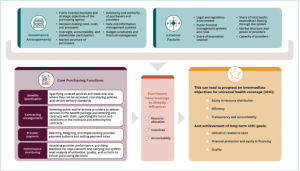From Fragmentation to Focus: Leveraging Strategic Health Purchasing Amid Conflict and Crisis

The Amref Health Africa team, with Country Representatives at the International Health Economics Association 2025 Congress. CREDIT: Rahul Kadarpeta
Africa faces a persistent challenge in financing healthcare, often characterised by limited public spending, high out-of-pocket payments, low domestic funding, and fragmented donor and funding flows. To tackle these challenges, countries are turning to Strategic Health Purchasing (SHP)—a smarter approach to delivering better health outcomes for every dollar spent, ensuring more equitable and accountable use of both domestic and donor resources.
“Strategic Health Purchasing can improve how a health system uses information on population health needs and provider performance to more effectively allocate resources to health providers—even in fragile settings.” – Boniface Mbuthia, Technical Director, Health Financing, Amref Health Africa
During the recent International Health Economics Association (IHEA) Congress, Joint Learning Network, Amref Health Africa and government representatives from Malawi, South Sudan, and Zambia discussed how SHP is being applied in different country contexts to identify, prioritise, and track health system strengthening opportunities and activities that accelerate Universal Health Coverage (UHC).
Speakers also shared how they used the SHP Progress Tracking Framework, developed by the Strategic Purchasing Africa Resource Centre (SPARC), to map purchasing functions across health systems and financing schemes. The framework helps countries gain a clear picture of their current capabilities and gaps in key areas related to SHP, including governance arrangements, policy and legal frameworks, and purchasing functions. To date, policymakers in more than 20 countries across Africa and Asia have used the framework to guide their health financing reforms.

SHP Progress Tracking Framework (SPARC)
Here are four key learnings from the session:
1. Harness Pooled Funding Mechanisms
Pooled funds, including those from donors, create opportunities to purchase health services more strategically and sustainably—even in fragile states. South Sudan’s Health Sector Transformation Project (HSTP) is a powerful example, providing significant opportunities for enhancing provider-purchaser engagement, performance monitoring, contracting, and reforming provider payments.
“Pooled health funds provide the financial resources, while strategic purchasing provides the mechanism to effectively and efficiently use those resources while aligning them to broader health goals,” Dr. John Rumunu, Director General of Health Policy Planning, Budgeting, and Research, South Sudan Ministry of Health.
In Malawi, the Health Sector Strategic Plan III (2023-2030) is being used to advance “one plan, one budget” policy reforms to consolidate health resource flows and encourage the use of service level agreements (SLAs) currently for faith-based facilities.
2. Build Responsive Health Systems Through Strong Governance
Strong governance emerges as the foundation that makes strategic health purchasing work in practice. Zambia is navigating ambitious reforms that include strengthening the National Health Insurance Scheme and transferring health system governance to local District Councils under the Ministry of Local Government. While complex, these reforms present an opportunity to reimagine how different purchasing entities can work together to increase utilisation, equity, financial protection, and quality care.
In South Sudan, the Ministry of Health chairs the HSTP, creating a platform where donor funding, government priorities, and health system strengthening align. This governance structure doesn’t just manage resources—it offers an opportunity to build sustainable institutional capacity.
3. Contract with Health Facilities
When health facilities have more control over their finances and operations and clear performance-based agreements, they deliver better care, respond more efficiently to the needs of their communities, and achieve better health performance with purchasing agencies. In Malawi, faith-based health facilities partner with the government through the Christian Health Association of Malawi or CHAM. They receive direct funding and operate with greater independence, enabling more responsive care.
“Lessons from the use of SLAs for faith-based facilities are essential to guide further reforms on how we purchase health services—even from public facilities,” says Gladstone Mchoma, Health Economist with Malawi’s Ministry of Health.
Zambia is using the National Health Insurance Management Authority to formally contract with private providers, providing a mechanism to specify service scope, pricing, and quality standards.
4. Connect Performance Data to Funding Decisions
Countries across Africa collect vast amounts of health data, but this information doesn’t always influence how funding is allocated. Closing this gap is essential for strategic purchasing to work effectively. To address this, countries can redesign their processes so that performance information motivates purchasing decisions. This means rewarding facilities that deliver quality care efficiently while providing support to those who are struggling.
While Zambia has a complex system for tracking health services and managing finances, district officials report that the data don’t always translate into financial decisions and that funds often flow regardless of performance. Local capacity and authority to make evidence-based decisions are crucial for making strategic purchasing work in practice.
Dr. Chrispine Sichome, Director of Health Policy for Zambia’s Ministry of Health, emphasised that “tackling these challenges will not only accelerate progress toward UHC but also provide valuable insights for other low- and middle-income countries pursuing similar health financing reforms.”
The Way Forward
The learnings gathered from these three countries show that SHP can be used to strengthen even constrained health systems, and tools like the SHP Progress Tracking Framework provide a way to move beyond good intentions to measurable progress.
Strategic health purchasing represents not just a financing reform, but a comprehensive approach to get better health outcomes for every person and every dollar spent.
————————
These lessons were originally shared at the International Health Economics Association 2025 Congress in Bali, Indonesia (July 19-23, 2025). The authors would like to thank Hallie Goertz for her strategic communications support.
Authors: Rahul Kadarpeta, Boniface Mbuthia, Gladstone Mchoma, Frida Ngalesoni, Lizah Nyambura, John Rumunu, Chrispine Sichome
Read also here: Amref Newsroom
